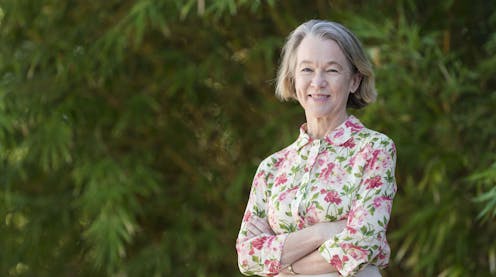Gabrielle Carey was best known for Puberty Blues – but I knew her as a formidable intellectual who mastered the art of living well
- Written by Russell Smith, Lecturer in English, Australian National University

The last time I saw Gabrielle Carey, who died this week, aged 64, was a couple of weeks ago in Sydney. I’d texted that I was coming to Sydney for the weekend, and she texted back to say she was meeting “a couple of Joyceans” for a morning walk in Lavender Bay and would I like to join them?
“Joyceans” was an important code-word for Gabrielle. She is still best known as the coauthor, with Kathy Lette, of Puberty Blues[1] (1979), a book she wrote as a teenager. The novel, a gritty account of the brutally sexist surf culture of Sydney’s southern beaches, was a smash hit, as was the film adaptation[2] directed by Bruce Beresford two years later. For Gabrielle, it was an early fame she would never entirely succeed in escaping.
But for many of those who knew Gabrielle later in life, she was, among many other things, a “Joycean”, and more particularly, a “Wakean[3]”.
She was a lifelong scholar of James Joyce, the towering Irish modernist writer whose last book, Finnegans Wake[4] – a 628-page novel written in an invented language mixing the most arcane English vocabulary with more than 60 other languages in an almost unreadable riot of wordplay – is justly notorious as the most fiendishly difficult book ever written. As Gabrielle writes[5]:
Wake language is a language of its own. Once you get the hang of it, Wakean words become a kind of code to share. If you’re finding it hard to make a decision, you can say you’re in “twinsome twominds” and your fellow Wakeans will understand. Or if you have some gossip, you can say “I’ve got a seeklet to sell.” Or if you just want to exclaim, you can invert a cliche: “O for a fresh of breath air!” Or if someone asks why you’re doing something, you can respond, “Just for the halibut.”
Gabrielle was an internationally respected expert on the Wake. She was in regular correspondence with the leading scholars; she was the author of numerous acclaimed essays on Joyce.
She was a performer, along with a number of other Wakean women, in the “Prankqueans”, a musical troupe named after one of the Wake’s characters and dedicated to performing the opera and popular song that is so richly studded throughout Joyce’s writing. And she was the leading light of not one, but two Finnegans Wake reading groups.
Her last book, currently in press, is simply titled James Joyce: A Life[6]. But, by contrast with Joyce, her own style was often so modest and accessible and democratic, albeit with a fierce and fearless honesty, that it is easy to underestimate the formidable intellect at work behind her writing.
Authors were ‘living beings’ for her
After Puberty Blues, Gabrielle Carey would go on to publish nine other books, spanning fiction, biography and memoir, as well as numerous essays and newspaper pieces.
















